Performance of the Year
Digitalisation and digital inclusion
The protection of information is a fundamental issue, as well as a topic of attention and responsibility, with reference to the complex information system that is managed. Therefore, Sogei's activity must be carried out considering the current and potential consequences of the issues concerning the protection of privacy and the security of information systems, which hold sensitive information of various kinds of private (natural and legal persons) and public subjects.
Through its activities, Sogei is involved in 77 lines of action (LDA – 23 direct and 54 indirect) compared to the 122 lines envisaged by the Three-Year Plan assigned to the Public Administration, with an involvement percentage of approximately 63%.
The path of digital transformation of Sogei saw the development of 16 technological innovation projects and 19 process innovation projects and ended with analysis and in-depth analysis activities, aimed at outlining a Data and Analytics (D&A) Model of company reference.
During the year, despite remote work and the inability to access classroom training courses, staff were able to participate in 161 events aimed at reducing the digital gap.
#NoidiSogei: Skills and knowledge for innovation: open new window
Security and Data protection
The protection of information is a fundamental issue, as well as a topic of attention and responsibility, with reference to the complex information system that is managed. Therefore, Sogei's activity must be carried out considering the current and potential consequences of the issues concerning the protection of privacy and the security of information systems, which hold sensitive information of various kinds of private (natural and legal persons) and public subjects.
From the perspective of Sogei as Data Controller, no possible violation of personal data was detected, while with Sogei considered as Data Manager, 9 personal data violation events occurred, which were managed, resolved and communicated to the Data Controllers, Sogei's institutional customers.
3,196 events were classified by various types of event/accident and divided into the different areas of the Sogei CERT Constituency. Specifically:
- cases of malware (35.8%): identified in emails and in other malicious code vectors, addressed by activating the appropriate IT security structures to update the protection and removal systems;
- possible threats to the infrastructures and services managed by Sogei (52.2%): possible attack vectors or exploitation of vulnerabilities identified (through information from intelligence sources and CERT research activities), managed by activating the appropriate company structures for risk mitigation or resolution of the potential vulnerability;
- events related to spam and phishing (10.8%): identified, thanks also to user reports, in deceptive emails that aim to steal the credentials of sites and services, resolved by blocking the sites linked to them;
- events relating to the disclosure and leakage of credentials (1.2%): in almost all cases, these are institutional emails associated with passwords that cannot be traced back to "corporate" accounts. These credentials, exfiltrated from third party sites and portals not always known through successful attacks (Data Breach), are collected by CERT through dedicated intelligence channels and communicated directly to users themselves (in the case of a Sogei employee) or to the cyber security structure of the entity involved (in the case of SIF) or to the CERT-MEF (in the case of the Economics Departments).
During 2020, audits and assessments were conducted for the security of information processed by critical ICT services. 6 audits were carried out during the year.
Security and data protection management: open new window
Development of ICT systems/services to combat illegality
The services that Sogei carries out have, among other objectives, the task of contributing structurally to ensuring the legality and regulatory compliance that governs the activities performed nationally and the related obligations. The control and monitoring of compliance with the regulations requires infrastructure systems and ICT services that are capable of providing effective and efficient support in this regard.
Over time, Sogei has developed 89 advanced tools that combat illegal phenomena, of which 34 directly and 55 indirectly.
Intelligence and controls: open new window
Quality and reliability of services
Quality and reliability of services are extremely important conditions that characterise the management of both relations with direct customers and with the end users of the services. By quality it is meant the level of customer satisfaction and the company's ability to respond to the underlying requests adequately and promptly.
- Response times on simulated user transactions, calculated on the most significant services (classified as Platinum): the index in 2020 reached an average value below one second (0.63 sec vs. 0.96 sec in 2019).
- Incidents resolved in relation to the type and according to the overall events (ITIL Methodology): the 2020 value is equal to 0.64% (vs. 0.82% in 2019) of emergencies with respect to the events that have occurred, i.e. malfunctions without impacting on the services, demonstrating the very high level of reliability of the design and construction;
- The data centre renewal rate is 16.2%.
Infrastructures - Technology: open new window
GRI
- GRI 418-1
Other indicators
- DIG-1
- DIG-2
- DIG-3
- DIG-4
- ILL-1
- ILL-2
- QAS-1
- QAS-2
- QAS-3
- SDP-3
- SDP-4
The economic-financial performance: open in new window
| Summary income statement (thousands of Euro) | Financial Statements 2020 |
Financial Statements 2019 |
Variation | Percentage variation |
|---|---|---|---|---|
| Revenues from sales and services | 625,665 | 576,002 | 49,663 | 8.6% |
| Variation in job orders in progress | 2,530 | 1,689 | 841 | 49.8% |
| Production value | 628,195 | 577,691 | 50,504 | 8.7% |
| Consumable materials and services | (379,148) | (330,166) | (48,982) | 14.8% |
| Value added | 249,047 | 247,525 | 1,522 | 0.6% |
| Cost of work o | (161,512) | (160,918) | (594) | 0.4% |
| Normalised EBITDA (*) | 87,535 | 86,607 | 928 | 1.1% |
| Depreciation and write-downs of fixed assets | (42,628) | (36,188) | (6,440) | 17.8% |
| Provisions for risks and charges | (7,341) | (13,326) | 5,985 | -44.9% |
| Other income and expenses | (146) | 3,736 | (3,882) | -103.9% |
| Operating result | 37,419 | 40,829 | (3,410) | -8.4% |
| Net income from equity investments | 185 | 268 | -83 | -31.1% |
| Financial income and charges balance | (259) | (183) | -76 | 41.4% |
| Pre-tax profit | 37,345 | 40,913 | (3,568) | -8.7% |
| Taxes | (10,387) | (11,079) | 692 | -6.3% |
| Profit for the period | 26,959 | 29,834 | (2,875) | -9.6% |
(*) As a result of reclassification of the component relating to the implementation of the "Generational Value" project, from labour costs to provisions for risks and charges.
| Cash flow statement (thousands of Euro) | 2020 | 2019 |
|---|---|---|
| Cash flows from operating activities | 61,602 | 54,158 |
| Cash flows from investment activities | (50,187) | (39,603) |
| Cash flows from financing activities | (34,834) | (32,810) |
| Net increase (decrease) in liquidity | (23,419) | (18,255) |
| Cash at the beginning of the period | 48,776 | 67,031 |
| Cash at the end of the period | 25,357 | 48,776 |
Generation and distribution of economic/financial value
In order to create and distribute economic and financial value to all stakeholders, also with the aim of ensuring their economic sustainability, Sogei cannot ignore the achievement of sustainable economic and financial performance.
| Value generated (thousands of Euro) | Financial Statements 2020 |
Financial Statements 2019 |
Variation | Percentage variation |
|---|---|---|---|---|
| Production value | 632,242 | 584,934 | 47,308 | 8.1% |
| Intermediate costs of production | ||||
| B10) Depreciations and write-downs | (42,628) | (36,188) | (6,441) | 17.8% |
| B12) Provision for risks | (3,191) | (2,326) | (865) | 37.2% |
| B14) Other operating costs | (2,771) | (2,590) | (181) | 7.0% |
| Characteristic generated value | 583,652 | 543,830 | 39,822 | 7.3% |
| Accessory management | ||||
| C15) Income from equity investments | 185 | 268 | (83) | -30.9% |
| C16) Other financial income | 26 | 110 | (84) | -76.2% |
| C17 bis) Exchange gains and losses | (5) | (10) | 5 | -50.8% |
| Total generated value | 583,858 | 544,197 | 39,661 | 7.3% |
| Distributed value (thousands of Euro) | Financial Statements 2020 |
Financial Statements 2019 |
Variation | Percentage variation |
|---|---|---|---|---|
| Suppliers | 379,148 | 330,166 | 48,981 | 14.8% |
| Community | 11,809 | 11,997 | (187) | -1.6% |
| Persons | 165,662 | 171,918 | (6,256) | -3.6% |
| Shareholderstd> | 26,959 | 29,834 | (2,875) | -9.6% |
| Lenders | 280 | 283 | (3) | -1.0% |
| Distributed economic value | 583,858 | 544,197 | 39,661 | 7.3% |
Suppliers: production costs (B6, B7, B8)
Community: income taxes for the year, indirect taxes and taxes
People: labour costs (B9)
Shareholder: profit for the year
Lenders: interests and other financial charges (C17)
Innovation - implementation of investment plans
The innovation of products and processes is one of the main levers to ensure the sustainability and durability of the organisation. These aspects must find consistency with the investment plan and its implementation, always taking into account the context in which Sogei operates.
Investments
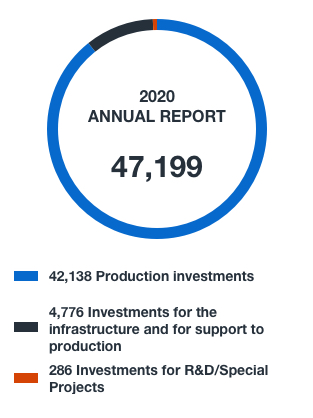
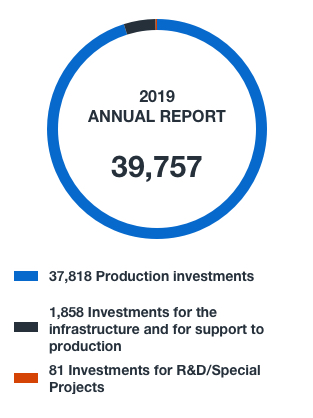
(values expressed in thousands of Euro)
GRI
- GRI 201-1
- GRI 203-1
Other indicators
- ECO-1
Ethics and integrity in performing business - Corporate conduct and Digital ethics
Managing a company requires the application of a code of ethics and compliance with principles that are able to guarantee reliable management of the activities and business, such as to allow the generation of value for all stakeholders in the short, medium and long term. During 2020:
- no episodes of corruption were ascertained. In addition, during the reporting period, an anonymous report was received that was considered insignificant, which in any case received a response from the RPCT [Prevention of Corruption and Transparency Manager]
- the evaluation activity of the Ethics & Compliance Committee, reporting periodically to the Board of Directors and to the other control bodies, led to the classification of 1 case of conflict of interest, declared "apparent".
Compliance with industry laws and regulations
A condition for the very existence of the organisation is compliance with the rules (laws and regulations of the reference sector) in the governance of company activities. During 2020:
- no sanctions, even non-monetary ones, were issued against Sogei for non-compliance with the laws and regulations. Additionally there were no legal actions relating to unfair competition, antitrust and monopolistic practices;
- there are no administrative, fiscal or tax sanctions;
- no non-compliance with environmental laws and/or regulations was found which resulted in the application of pecuniary penalties and non-monetary sanctions.
GRI
- GRI 205-3
- GRI 307-1
- GRI 419-1
Other indicators
- GOV-1
- GOV-3
Natural Capital: open new window
Green ICT – responsible use and management of resources
Sogei is called upon to actively contribute to reducing the impact of ICT systems on the environment through a more efficient use of natural resources and materials, also through effective waste management and the sustainable and efficient management of water resource consumptions for industrial purposes.
| Water extraction (Ml-Megalitres) | 2020 | 2019 | ||
|---|---|---|---|---|
| All the areas | Water stress areas | All the areas | Water stress areas | |
| Surface waters | ||||
| Fresh water (≤1.000 mg/L Total Dissolved Solids) | - | - | - | - |
| Other types of water (> 1,000 mg/L Total Dissolved Solids) | - | - | - | - |
| Total surface waters | - | - | - | - |
| Groundwaters/Well Waters | ||||
| Fresh water (≤1.000 mg/L Total Dissolved Solids) | - | - | - | - |
| Other types of water (> 1.000 mg/L Total Dissolved Solids) | - | 56.0 | 71.0 | |
| Total groundwaters/well waters | - | 56.0 | - | 71.0 |
| Sea water | ||||
| Fresh water (≤1.000 mg/L Total Dissolved Solids) | - | - | - | - |
| Other types of water (> 1.000 mg/L Total Dissolved Solids) | - | - | - | - |
| Total sea water | - | - | - | - |
| Water produced | ||||
| Fresh water (≤1.000 mg/L Total Dissolved Solids) | - | - | - | - |
| Other types of water (> 1.000 mg/L Total Dissolved Solids) | - | - | - | - |
| Total water produced | - | - | - | - |
| Third Party Water Resources/ Public Aqueducts | ||||
| Fresh water (≤1.000 mg/L Total Dissolved Solids) | 35.5 | 54.1 | ||
| Other types of water (> 1,000 mg/L Total Dissolved Solids) | - | - | - | - |
| Total third party water resources/Public aqueducts | - | 35.5 | - | 54.1 |
| Total water extraction | - | 91.5 | - | 125.1 |
1 The definition of freshwater/other types of water, adopted by the GRI Standards, is based on the ISO 14046:2014 standard and on the USGS (United States Geological Survey) document, Water Science Glossary of Terms, water.usgs.gov/edu /dictionary.html, (accessed 1 June 2018) and on the WHO (World Health Organisation) document Guidelines for Drinking-water Quality of 2017.
Energy consumptions and emissions - mitigation of climate change impacts
The energy profile of an ICT infrastructure takes on greater importance in relation to the effects and impacts on the environment of its emissions regarding the need to mitigate the negative effects of climate change.
CED parameters
| CED parameters | 2020 | 2019 |
|---|---|---|
| PUE of the CED | 1.73 | 1.73 |
| Number of physical servers present | 1,161 | 957 |
| Number of virtual servers | 6,967 | 6,178 |
| Server consolidation ratio | 6.0 | 6.5 |
| Terabytes installed in the CED | 32,000 | 30,000 |
| Total energy consumption | 2020 | 2019 | |
|---|---|---|---|
| Electricity (GWh) | CED | 29,986 | 27,506 |
| Offices | 3,714 | 5,922 | |
| Building complex A | 33,700 | 33,428 | |
| Building complex B (Offices) | 1,782 | 2,078 | |
| Total (fully certified renewable) | 35,482 | 35,506 | |
| Natural GAS (Sm³) | Building complex A (Offices) | 315,903 | 388,665 |
| Building complex B (Offices) | 78,967 | 131,611 | |
| Total (not renewable) | 394,870 | 520,276 | |
| Total energy consumption in Gj | 2020 | 2019 | |
|---|---|---|---|
| Electricity (GJ) | CED | 107,951 | 99,022 |
| Offices | 13,370 | 21,319 | |
| Building complex A | 121,321 | 120,341 | |
| Building complex B (Offices) | 6,415 | 7,481 | |
| Total (fully certified renewable) | 127,736 | 127,822 | |
| Natural GAS (GJ) | Building complex A (Offices) | 11,097 | 13,653 |
| Building complex B (Offices) | 2,774 | 4,623 | |
| Total (not renewable) | 13,871 | 18,277 | |
For 2020, the December figure relating to electricity is estimated using the quarter-hour readings requested from the supplier, as the final consumption balance is not yet available.
Emissions
| Emissions t CO2 eq | 2020 | 2019 |
|---|---|---|
| Natural gas in Sm³ | 394,870 | 520,276 |
| Natural gas in GJ | 13,871 | 18,277 |
| Scope 1 - CO2 in ton (Gas) | 732 | 965 |
| Electricity in kWh | 35,482,275 | 35,506,014 |
| Electricity in GJ | 127,736 | 127,822 |
| Scope 2 - CO2 in tons (E. Electric) | - | - |
| Indirect emissions AVOIDED t CO2 | 2020 | 2019 |
|---|---|---|
| Electricity in kWh | 35,482,275 | 35,506,014 |
| Electricity in GJ | 127,736 | 127,822 |
| Scope 2 - C02 in tons (E. Electric) | 9,804 | 9,810 |
Direct emissions - For direct greenhouse gas emissions, connected to the combustion of natural gas for the winter heating of offices and for the production of DHW (domestic hot water) for the four canteens distributed in the two building complexes, the emission calculations were carried out using the emission factor for heat production indicated in the ISPRA reports, most recently the Report 317/2020 with the updated data for 2018 equal to 190.1 gCO2eq/ kWh.
Indirect emissions - The emissions linked to the consumption of electricity can be evaluated as zero, thanks to the purchase of RECS (Renewable Energy Certificate System) certified energy, that is, derived solely from renewable sources. For electricity, therefore, the value of emissions avoided is indicated, calculated using the emission factors reported by ISPRA in the 317/2020 report, equal to 281.4 gCO2/kWh for 2018 and 276.3 gCO2/kWh for 2019. (value also used for 2020, as it has not yet been updated).
GRI
- GRI 302-1
- GRI 302-3
- GRI 303-3
- GRI 305-1
- GRI 305-2
Other indicators
- PUE
Social and relationship Capital (Social and relationship Capital) : open new window
Responsible management of the supply chain
Sogei cannot ignore the management of its supply chain to maintain and ensure a truly sustainable profile. This is based on mechanisms and tools that are able to guarantee, over time, full control of its supply chain and full collaboration and total sharing of an overall sustainable procurement strategy.
During 2020:
- the contracts stipulated on purchase procedures managed by Consip or using the purchase instruments (conventions, framework agreements) always made available by Consip, net of additions or extensions, amount to 84% of the total stipulated;
- tenders were awarded with the EV criterion to the extent of 52% of the total value of the tenders awarded in the same year;
- penalties were contested for a value of less than 0.07% of the overall use of existing contracts.
Consip makes use of tools that provide for the inclusion in the award procedures of environmental and social requirements and criteria such as the Minimum Environmental Criteria (CAM) and additional environmental and social criteria. The latest data available, referring to 2019, highlights how the "green" disbursement managed by Consip as a whole of its activities, has reached a total value of Euro 5.5 billion (compared to 5 billion in 2018), of which 3 billion relating to the Conventions, 2.2 billion relating to the use of the Electronic Market of the PA (Mepa) and the remaining 0.3 billion deriving from the use of Framework Agreements and the Dynamic Purchase System of the PA (Sdapa), equal to approximately 40, 44% of the total value of purchases made through e-procurement tools.
GRI
- GRI 308-1
- GRI 414-1
Other indicators
- GSC-1
- GSC-2
- GSC-3
#NOIDISOGEI: The value of people: open new window
Human resources - People value
At 31 December 2020, the Sogei population amounted to 2,210 people, all hired with permanent contracts.
| Workforce | 2020 | 2019 |
|---|---|---|
| No. of employees | 2,210 | 2,144 |
| Person years | 2,163.7 | 2,170.3 |
Talent attraction capacity
Human capital and its related skills are the basis of the management and development of an organisation. The ability to attract talent is therefore one of the indicators with which to measure the value of an organisation and helps to strengthen the identity and purpose of the same. Therefore, the ability to use “talents” within Sogei allows the enhancement of skills, the strengthening of the business culture, an increase in the degree of involvement and a sense of belonging.
| Recruitments by profile | |
|---|---|
| Apprentices | Number |
| IT Architect and Data Model Analyst Recent Graduates | 2 |
| NICT Consultant Recent graduates | 2 |
| IT Recent Graduates | 22 |
| Corporate Recent Graduates | 21 |
| IT Diplomats | 67 |
| Total apprentices | 114 |
| Experts | Number |
| Data Model Analyst Experts | 5 |
| IT Architect Experts | 1 |
| IT and Cyber Security Specialist | 3 |
| Macroeconometric Models Experts | 6 |
| Treasury Expert | 1 |
| CX Designer Experts | 6 |
| Total experts | 22 |
| Manager | Number |
| Finance and Corporate Affairs Director | 1 |
| People Development Manager | 1 |
| CX Design Manager | 1 |
| Organization Manager | 1 |
| IT Architecture and Innovation Manager | 1 |
| Cybersecurity Manager | 1 |
| Total manager | 6 |
For the entire period of the 30-month apprenticeship, the new hires are supported by an HR Tutor, who accompanies them in the path of growth and autonomy, and by a Technical Tutor who is the reference for all aspects most closely related to the work in the Organisational Units. In 2020, the tutoring process involved 210 apprentices (the number includes both those who were hired in 2020 and in the previous 2 years), 144 technical tutors and 11 HR tutors. 70 new tutors received dedicated training. There were 1,070 tutoring meetings in total, most of which were group meetings in order to facilitate dialogue, integration and the sharing of experiences, as well as to streamline the process itself, in anticipation of the significant increase in new employees. The total commitment in hours was approximately 520.
Workforce evolution and average age
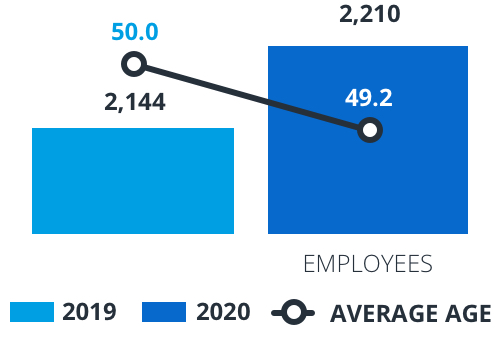
Workforce evolution by age groups
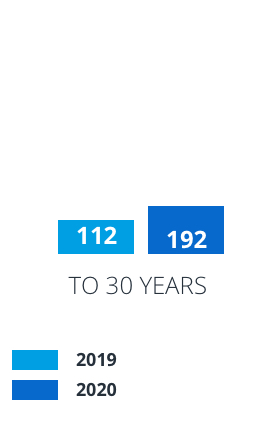
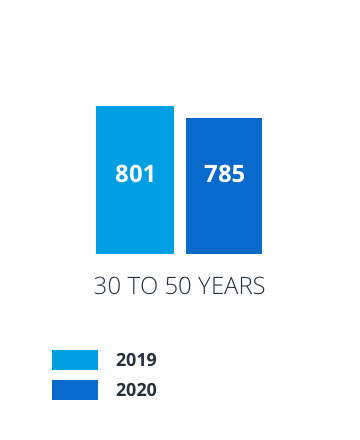
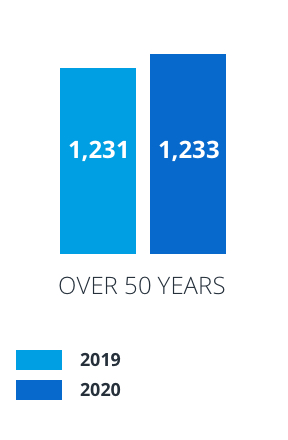
Percentage distribution by qualification
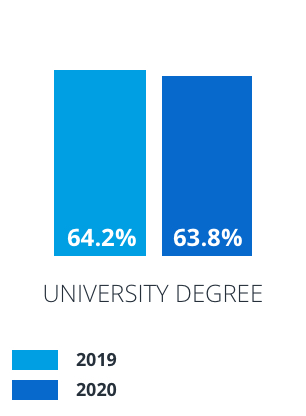
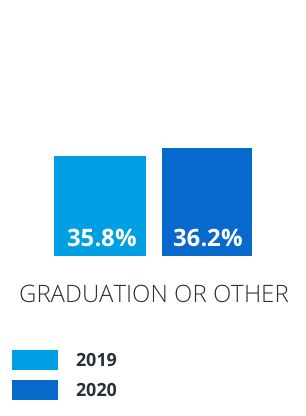
Training and skills development
The duration over time and the sustainability of Sogei include the need to invest concretely in the development of human resources with training courses suitable for enhancing skills and to ensure a human capital capable of allowing the creation of value by the organisation, also with the services provided.
| Profile (hours) | Women | Men | Total |
|---|---|---|---|
| Executives | 264 | 460 | 724 |
| Managers | 1,960 | 3,032 | 4,992 |
| Office staff | 4,024 | 6,876 | 10,900 |
| Soft skills training - Total | 6,248 | 10,368 | 16,616 |
| Executives | 8 | 44 | 52 |
| Managers | 156 | 224 | 380 |
| Office staff | 584 | 1,120 | 1,704 |
| Regulatory Training - Total | 748 | 1,388 | 2,136 |
| Executives | 268 | 420 | 688 |
| Managers | 2,068 | 2,016 | 4,084 |
| Office staff | 4,900 | 3,900 | 8,800 |
| Specialist Training - Total | 7,236 | 6,336 | 13,572 |
| Executives | 16 | 4 | 20 |
| Managers | 504 | 1,496 | 2,000 |
| Office staff | 4,476 | 12,196 | 16,672 |
| Technological Training - Total | 4,996 | 13,696 | 18,692 |
| Executives | 556 | 928 | 1,484 |
| Managers | 4,688 | 6,768 | 11.456 |
| Office staff | 13,984 | 24,092 | 38,076 |
| Total Training | 19,228 | 31,788 | 51,016 |
Company welfare – Work/life balance
The achievement and improvement of the balance between professional and private life has acquired a concrete and essential importance for a company. An adequate welfare system can allow an overall improvement in the capacity of human resources to contribute to the development and strengthening of the performance of an organisation.
Percentage distribution of remote working and part-time work by gender
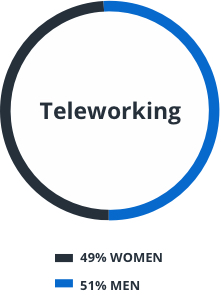
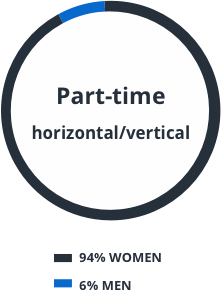
| Type | TOTAL | Women | Men | |||
|---|---|---|---|---|---|---|
| Value (average number) | % | Value (average number) | % | Value (average number) | % | |
| Horizontal/vertical part-time | 36.7 | 1.7% | 34.5 | 1.6% | 2.2 | 0.1% |
| Home working | 125.1 | 5.8% | 60.8 | 2.8% | 64.3 | 3.0% |
Diversity, contamination and equal opportunities
The creation and maintaining of a work environment capable of guaranteeing and protecting diversity and inclusiveness are central factors for the management of Sogei's human resources.
| Manager (No.) | 2020 | 2019 |
|---|---|---|
| women | 57 | 53 |
| men | 85 | 79 |
Workforce evolution by gender and age group
Women
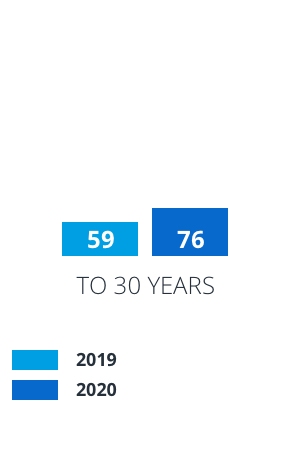
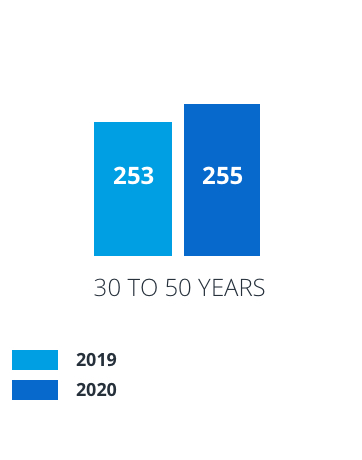
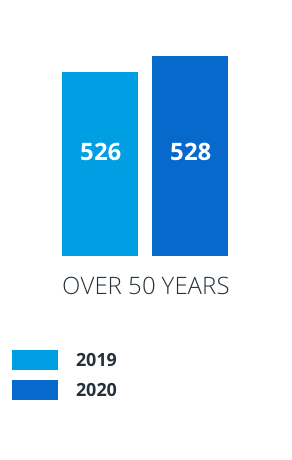
Men
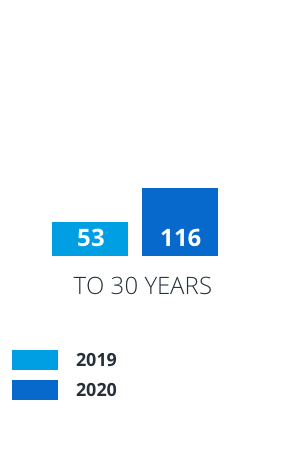
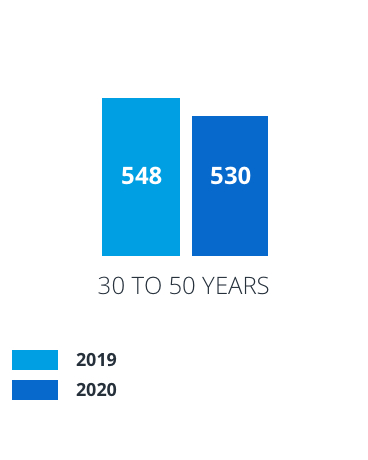
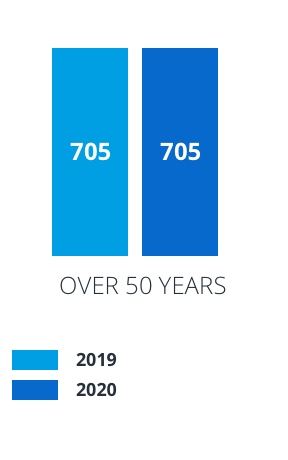
Percentage distribution by gender and category
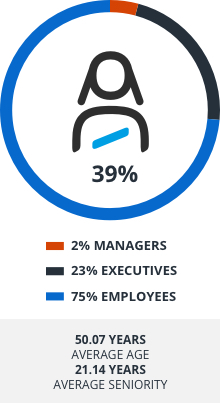
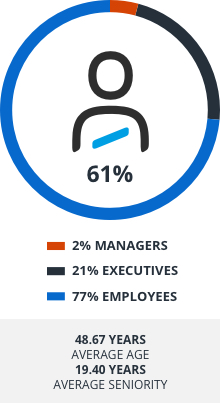
Occupational health and safety
The constant monitoring of sensitive processes, with particular attention to the prevention of accidents and occupational diseases, both for its personnel and for interested third parties, is an essential issue for Sogei's business management.
In the course of 2020, against a total of over 3.4 million hours worked, 11 accidents occurred, of which 7 during work-related travel; it should be noted that the 4 accidents that occurred during work activities (in company offices or at home) mainly concerned slips, falls and impacts, not attributable to performing of the work task and none of particular severity. Finally, for the year 2020 an injury rate was recorded (compared to 1 million hours worked) of 3.23 with injuries while travelling and 1.17 without injuries while travelling.
GRI
- GRI 401-1
- GRI 404-2
- GRI 405-1
- GRI 406-1
- GRI 403-9
Other indicators
- PVT-3
- PVW-1
- PVW-2
